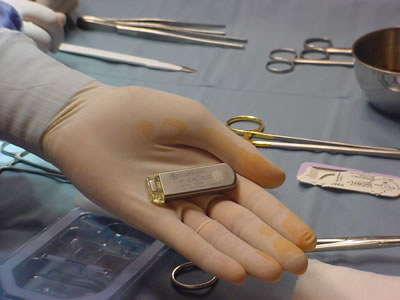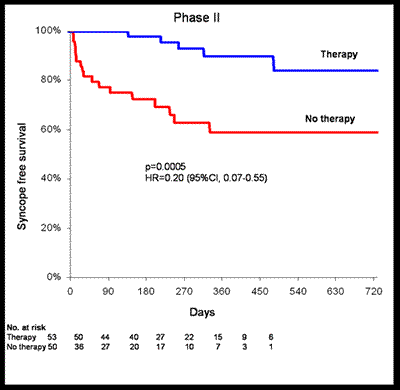Rationale
In conventional practice - besides electrocardiographic (ECG) documentation of syncope - therapy of neurally-mediated syncope (NMS) has been principally empirical or guided by the results of tilt-table testing.
Controlled trials of tilt-guided therapy, however, have often failed to show a benefit and the evidence of efficacy for empirical therapy of neurally-mediated syncope is weak (1,2,3). Specifically, the efficacy of pacemaker therapy was questioned after two recent controlled trials failed to prove the superiority of cardiac pacing over placebo in unselected patients with positive tilt testing (4,5). This is not surprising if we consider that the mechanism of syncope is heterogeneous and therefore there is the need to assign a specific therapy for each individual patient.
The International Study on Syncope of Uncertain Etiology 2 (ISSUE 2) (6) was a multi-center, prospective, observational study enrolling 442 patients with a diagnosis of suspected NMS from centers across Europe and the USA. The study assessed the effectiveness of a diagnostic and treatment strategy based on the initial evaluation described above, early implantable loop recorder (ILR) implantation, and ILR-based specific therapy after syncope recurrence.

Initial evaluation
It is generally agreed that, in accordance with the guidelines of the European Society of Cardiology (1,2), by relatively straightforward initial evaluation (patient history, physical examination, standard electrocardiogram, and measurement of supine/upright blood pressure), it is possible to risk-stratify patients with syncope. Specifically, this approach can effectively identify patients likely to have cardiac syncope, and who would benefit from further cardiovascular investigations. Furthermore, based on the initial evaluation, a neurally-mediated mechanism can be suspected, irrespective of the results of tilt testing (7,8,9). Therefore, based only on this initial evaluation, a group of patients with suspected NMS can be identified with a high level of certainty, and followed through the implantation of a loop recorder (ILR). The cost of the ILR (Reveal, Medtronic) is approximately € 1500.
How to select patients suitable for Implantable Loop Recorder (ILR) strategy ?
In general, initial treatment of all forms of neurally-mediated reflex syncope comprises education regarding avoidance of triggering events, recognition of premonitory symptoms, and maneuvers to abort a syncope episode. Additional treatment may be necessary in high-risk or high-frequency settings, such as when (1,2):
- syncope is frequent, altering quality of life
- syncope is recurrent and unpredictable (absence of presyncope symptoms) and exposes the patient to high-risk trauma
- syncope occurs during high-risk activity (driving, machine operation, flying, etc.)
In these settings, long-term monitoring with an ILR may be appropriate.
In particular, in the ISSUE 2 study (6), only a minority of the patients ultimately received an ILR implantation. The ISSUE population was elderly, had a history of recurrent syncope beginning in middle or older ages and frequent injuries probably due to presentation without warning. Indeed, the mean age was >65 years, with a history of recurrent syncopes beginning in middle age or older; the number of syncopal episodes preceding study entry was between four and 10; median history of syncope was 7 years; 50% reported no warning at syncope onset; and 21% reported major injuries from at least one of the episodes (e.g., fractures, brain concussions); most patients (>85%) had normal ECGs and no structural heart disease. These findings partially differentiated these patient population from the general population of patients affected by neurally-mediated syncope.
The mechanism of syncope detected by ILR
Experience from ILR consistenly showed that the mechanism of syncope is heterogeneous with bradycardia or asystole accounting for approximately one-half of the syncope events (7,10,11,12). In ISSUE 2 in particular, among 106 ILR documented episodes:
- A long asystolic pause (median 11.5 sec duration) was present in 54% of cases
- Bradycardia < 40 bpm was present in 4% of cases
- No or slight rhythm variation were present in 27% of cases
- Progressive sinus tachycardia was present in 7% of cases
- Primary tachyarrhythmia was present in 8% of cases
Therapy guided by ILR findings
Based on this approach the logical recommended mechanism-specific therapies are:
- dual-chamber cardiac pacing in asystolic and bradycardic patients
- antiarrhythmic therapy (catheter ablation, implantable defibrilaltor or antiarrhythmic drugs as appropriate) in tachyarrhythmic patients
- counseling and non-specific therapy in patients with normal or slight rhythm variations or progressive sinus tachycardia
In the ISSUE 2-study, 53 patients received ILR-based specific therapy, mostly pacemaker therapy (n=47) and 50 patients received counseling (education and reassurance) and nonspecific therapy. Patient characteristics were well-matched for the two groups.
The 1-year recurrence rate in patients assigned to a specific therapy was 10% (burden 0.07?0.2 episodes per patient/year) compared with 41% (burden 0.83?1.57 episodes per patient/year) in the patients without specific therapy (80% relative risk reduction for patients, p=0.002, and 92% for burden, p=0.002). The 1-year recurrence rate in patients with pacemakers was 5% (burden 0.05±0.15 episodes per patient/year). Severe trauma secondary to syncope relapse occurred in 2%, mild trauma in 4% of the patients during the overall study period.
The content of this article reflects the personal opinion of the author/s and is not necessarily the official position of the European Society of Cardiology.
Conclusion:
A strategy based on early application of the ILR with therapy delayed until documentation of syncope allows a safe, specific and effective therapy for patients with recurrent suspected NMS. Further, based on the findings reported here, it seems reasonable to recommend that early ILR use become standard practice for management (diagnosis and treatment) of patients with severe recurrent suspected NMS.



 Our mission: To reduce the burden of cardiovascular disease.
Our mission: To reduce the burden of cardiovascular disease.